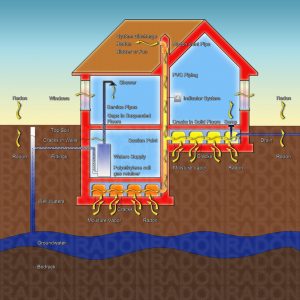 If you have a persistent cough, are wheezing, coughing up blood, have difficulty breathing, and are feeling very hoarse, then you have all the classic symptoms of a heavy smoker.
If you have a persistent cough, are wheezing, coughing up blood, have difficulty breathing, and are feeling very hoarse, then you have all the classic symptoms of a heavy smoker.
But if you don’t smoke, and if you’ve ruled out bronchitis, pneumonia, or other infections, then you may have been exposed to lung cancer’s second leading cause, according to the Surgeon General: radon.
While many think that natural gases are just that, natural, there are some naturally-occurring gases that we need to be wary of.
Radon is present both indoors and outdoors and can be found in both the air and water at very low levels. It is given off by soil and rocks as a byproduct of decay and can enter buildings through cracks in floors, walls, or open windows.
However, this usually happens at very low levels. Higher levels of radon are found deeper inside the Earth’s crust: in wells, canyons, or deep underwater.
While most people will not suffer from radon poisoning in their lifetime, some environments put people more at risk.
You Can Get Exposed To Radon At Work
Hundreds of years ago, miners were experiencing an extremely high number of cases of lung problems. Even worse, the death rates were very high. This was long before we knew what radon was. But in the 1950s and 1960s, studies of miners who’d been exposed to radon found that there was a link to their exposure and cases of lung cancer.
Those who work at uranium processing factories are also more prone to radon exposure and lung cancer. You might be thinking, I’m not a miner from the 1950s or involved in uranium production, so I’m safe, right? Unfortunately, those who work with phosphate fertilizers are also at risk. These fertilizers may have high levels of radium, which decomposes, producing radon. That means gardeners, landscapers, and agriculture workers may be regularly exposed to high radon levels.
Your Building or Home Can Expose You To Radon
It may sound crazy, but it’s possible that entire buildings could be responsible for radon exposure. Certain building materials are more prone to containing radon than others. Concrete and wallboard are two examples, although they give off radon in very small doses.
Natural rock and mineral materials, like granite, can also give off radon. Some people are wary of granite counter tops, avoiding them or keeping radon testing kits in their homes. Depending on the countertop and where it was sourced, some may give off higher levels than others. Fortunately, the U.S. Environmental Protection Agency says that it’s highly unlikely that granite counter tops can give off enough radon to cause health concerns.
In Colorado, levels of the dangerous gas are very high, which is why you should call a residential radon testing service annually (and every time you move).
Our affordable radon mitigation and abatement service prides itself in effective local radon testing to make sure both you and your loved ones are safe in your own home.

Recent Comments